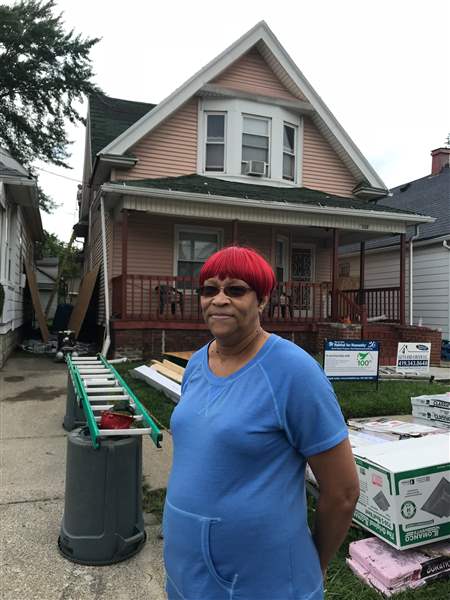
Neighborhood’s policy has simple rule: help the homeowner
8/23/2018
Rosalind Easterly stands outside of her home on Tecumseh Street.
THE BLADE/TOM TROY
Buy This Image

Tom Troy
A new paradigm for reviving Toledo’s neighborhoods is in the making, and not a moment too soon.
The old way has officially retired. That happened when Terry Glazer stepped down about three years ago as the executive director of the Lagrange Development Corp.
The Lagrange community development corporation was the epitome of the way neighborhood redevelopment was attempted back in the 1980s and 1990s.
Mr. Glazer, a native of New York City who came to Toledo as a community organizer and with a University of Pittsburgh degree in urban planning in the 1980s, brought energy and ideas, and a certain New York chutzpah to his work, which included service as a Toledo school board member.
Under him, Lagrange became one of the first community development corporations in Toledo and maybe its most successful. Lagrange created an office that could accept federal community development block grant funds, money intended to fight blight.
Lagrange rebuilt a block of rundown homes with 10 new homes, Heritage Village. Lagrange Development helped organize the community to form a Polish Village Council and ran the the Polish Festival on Lagrange Street.
Lagrange put together a neighborhood business plan and used revenue it earned along with the usual mix of tax credits, federal funds, city funds, and business loans to renovate a block of business buildings called The Shoppes on Lagrinka at Central Avenue and Lagrange Street.
After merging with NorthRiver Development Corp. to form United North, the organization partnered with area business groups to create new house construction around new schools.
The list goes on and on.
Did it work?
Lagrange Street, which is mostly a commercial stretch, looks pretty sad right now. The Polish Festival has moved to Holland.
Amazingly, however, residential real estate in that North Toledo neighborhood is considered one of the best buys in the country. An article in The Blade on Aug. 3 said a real estate firm that ranked nearly 20,000 neighborhoods gave Lagrange an “A” score for value.
The secret of Lagrange and a lot of Toledo is that, despite the reputation of the central city, there are a lot of well-maintained houses in these neighborhoods. The owners stubbornly hang on, and new ones come in, though maybe not fast enough to keep up with the blight.
The city’s maintenance of streets and parks and the even-handed protection of the police and fire departments helps keep these neighborhoods alive.
The biggest factor, though, is the commitment of the homeowners and law-abiding residents who remain.
It’s people like “urban farmer” Thomas Jackson, who has converted multiple empty city lots into agricultural lots at Auburn Avenue and Monroe Street.
It’s the people who call the police or post it on Facebook when they see a prowler or a burglar, a prostitute strutting on the street, someone trying to make a drug sale. It’s the people who mow their lawns, paint their fences, and decorate their lawns with truck tires filled with flowers.
Back in the ‘90s, the model of the community development corporation was a small organization with a director and some employees who were directly supported by the city. Too much money was spent paying people for projects that didn’t work.
Building new houses to sell to people has proven a risk, as too many of those houses end up poorly maintained, or even boarded up and then demolished.
Toledo has moved on from the CDCs, but what is it doing it in its place?
Hard to tell.
Mr. Glazer suggests solutions that have worked in other cities, such as the Kalamazoo Promise, which guarantees free college tuition to graduates of the Kalamazoo public schools. Problem is, the Kalamazoo Promise is paid for by an anonymous donor who over 13 years has put more than 5,000 students through college. Who’s offering to do that for Toledo?
Mr. Glazer wants the city to target its services to specific neighborhoods for short spurts in order to create dramatic makeovers. The problem is district councilmen want all city funding funding spent evenly.
Mr. Glazer also was a big supporter of a failed attempt to require rental homes to be inspected for minimum occupancy standards at the point of sale (POS). With the lead ordinance in legal tatters, maybe council should try that one again.
A good example of what works is the partnership going on between the city’s Neighborhoods and Business Development Office and Maumee Valley Habitat for Humanity. This very week, Habitat replaced its 100th roof, at the home of Rosalind D. Easterly, 62, at 1550 Tecumseh St. Water was leaking into most of the rooms and Mrs. Easterly was in danger of having to abandon her house, which would have left another crumbling central city wreck.
With help from the city, Owens-Corning, volunteers, and the contractor, Four Guys and a Roof, Mrs. Easterly got a roof that would have cost up to $12,000 for $1,500. At a news announcement on Wednesday they ended it with a prayer and a cheer.
Direct help to homeowners on the ground. Creation of any neighborhood redevelopment policy should start with a simple question: will this help someone like Rosalind Easterly stay in her home?
Contact Tom Troy at tomtroy@theblade.com, 419-724-6058, or on Twitter @TomFTroy.